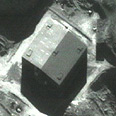
Intelligence photos of the reactor
צילום: AP
IAEA found uranium traces at alleged Syrian nuclear site
As UN nuclear watchdog agency prepares to write final draft of report on alleged Syrian reactor, diplomats indicate enriched uranium found at al-Kibar site bombed by Israel in 2007. Others, however, insist finding itself isn't smoking gun
The International Atomic Energy Agency (IAEA) found uranium at an alleged secret Syrian nuclear reactor site that was bombed by Israel last year, a diplomat told Deutsche Presse-Agentur in Vienna on Monday.
Another diplomat indicated that IAEA inspectors had found traces of the metal during their first visit to the al-Kibar site in the Syrian desert in June, which the Israeli Air Force bombed in September 2007.
Both diplomats spoke on condition of anonymity.
The Vienna-based nuclear watchdog is in the process of finishing its first written report on Syria since the United States provided the IAEA with intelligence in the spring indicating that Syria had almost completed a reactor, possibly with the help of North Korean experts.
"It wasn't natural uranium," the Western diplomat said, adding that this indicated it might have been enriched.
While uranium occurs naturally in soil, it has to undergo several chemical processes before it can be used in nuclear reactors.
Syria maintains that Israel bombed a conventional military site that was unrelated to nuclear uses. The finding did not mean that Syria had stored nuclear fuel at al-Kibar, and there were several ways that uranium particles could have ended up there, the second diplomat said.
For example, the particles could stem from contaminated equipment that was located at the installation.
'Maybe from making food additive'
The contamination could also come from Syria's nuclear research reactor or from its production of phosphoric acid, said David Albright, a non-proliferation expert who heads the ISIS institute in Washington.In the process of making phosphoric acid, a food additive, metals such as uranium are separated from phosphate rock.
If the IAEA had found uranium metal manufactured for use in a reactor, "that would be more serious," Albright said.
The second diplomat said that contrary to earlier expectations, the nuclear agency had not found graphite, a substance used in reactor cores.
The Israeli attack might have compressed the graphite underground, rather than scatter it on the surface where it can be detected, Albright said.
Several IAEA members, including the United States, have pressed IAEA Director General Mohamed ElBaradei to issue a report for the upcoming board meeting on November 27 and 28. The document is expected to be released to IAEA member states next week.
A senior Western diplomat said that the inspectors' investigation was only partly based on the analysis of soil samples taken at al-Kibar. In addition, the IAEA had also received additional intelligence that pointed to a possible involvement of North Korea in the alleged Syrian project.
Syrian officials have said they would consider additional visits by IAEA inspectors only after the agency has concluded the analysis of its first mission in June.










